Extras Menu
If a menu item in the table below is a hyperlink, click to see
examples.
| Options Code for Printing | Selecting this item outputs text to the MATLAB window
which can then be cut and paste into a script. The text contains
commands that set up the necessary options to recompute the current
plot exactly as a printable plot. Note that this option
requires the recomputation of the pseudospectra data, as well as
access to the original matrix. |
| Save for Quick Print Creation |
This option is similar to above, except that it
saves the necessary data for re-creating the current pseudospectra in
a .mat file. A printable plot can then be created almost instantly by
calling EigTool with a single argument, the name of the file the data
was saved in. |
| Projection Level | This parameter
controls the amount of projection to use when computing pseudospectra;
see the Projection Tutorial for information
on choosing good values. |
| Colour | Toggle colour or black lines
for the pseudospectra, useful if preparing plots for
publication. |
| Thick Lines | Toggle thick or thin
lines; thick lines are better for presentations (especially online,
where a data projector is being used), whilst thin ones are better for
publication plots. |
| Arbitrary Levels | Allows the use of epsilon levels which are not equally
spaced, and hence cannot be entered using EigTool's standard Contour Levels
pane. |
| Accuracy of FoV Comp. | By default the
field of values (numerical
range) is computed by connecting 40 points on its exterior using
straight lines. This option allows the default value to be changed if
finer resolution is required (the number must be even). |
| Departure from Normality | This
option will compute Henrici's departure from normality for the
current matrix. This is defined to be the Frobenius norm of N
where N = T-diag(li), T is the Schur
factor of the matrix and diag(li) is the diagonal
of T. |
| Display Eigenvalues | For some plots it
may be desirable to remove the eigenvalues (for example if it is known
that the pseudospectra are correct for a particular discretisation,
but the eigenvalues are not). |
| Display Pseudospectra | Similarly, there
may be cases where only the eigenvalues are of interest, and the
pseudospectra need to be turned off. |
| Display Dimension | Displays the
dimension of the matrix in the bottom left hand corner of the
axes. This is useful for determining the size of the projected matrix
if projection is being used. |
| Display Gridpoints | Displays the grid
used for the pseudospectra computation; EigTool computes the norm of
the resolvent inv(z*I-A) at points z in a grid over the current
portion of the complex plane. |
| Display Imaginary Axis | This item
toggles the display of a grey line on the imaginary axis, useful for
determing the stability of certain operators. |
| Display Unit Circle | This item toggles
the display of a grey line on the unit circle, useful for determing
convergence properties in certain applications. |
| Display Colourbar | This item toggles
the display of the colourbar showing the different epsilon levels
plotted by EigTool. This is especially useful for creating printable
plots without the colourbar. |
Some specific examples
Options Code for Printing
As an example of creating options code, we will show how we created
the options for the Orr-Sommerfeld demo from the Demos menu. The following commands can be used
to create the matrix and start EigTool: A =
orrsommerfeld_demo(100);
eigtool(A);
The initial plot created by EigTool is shown below:
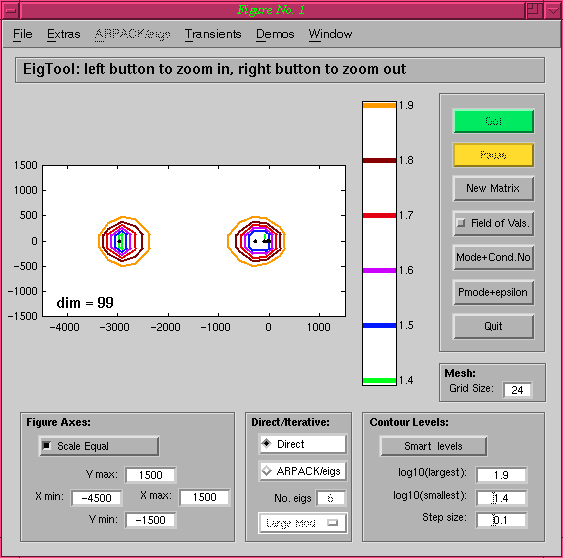
For this discretisation, it is known that only the rightmost
eigenvalues approximate those of the operator, so we change the axes
using either the text boxes or the mouse to focus on the area we
want. Adding the imaginary axis allows
us to see whether this operator is stable (which side of the line does
the rightmost eigenvalue lie on?), and increasing the number of grid
points to 50 gives a smooth plot:
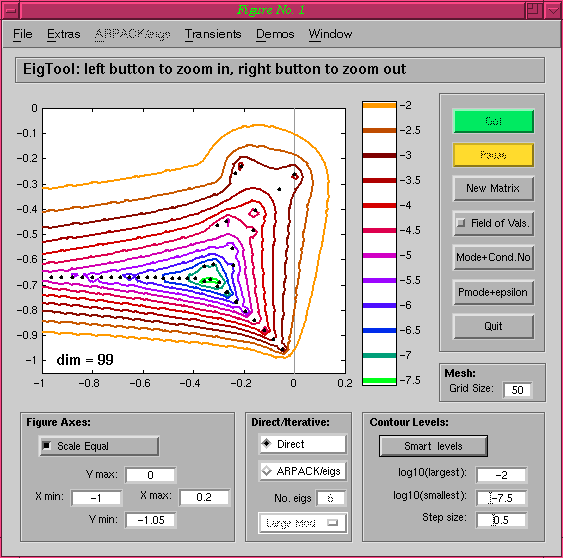
If the Options Code for Printing menu option is now selected, the
following text is output in the main MATLAB window:
% Run the following commands to set up the necessary
% options to create a printable plot of the pseudospectra.
% Create the plot using 'eigtool(A,opts)' where A is your matrix.
% (If you are using eigs, simply pass these options along with
% the eigs options to eigs itself.)
opts.npts=50;
opts.levels=-7.5:0.5:-2;
opts.ax=[-1 0.2 -1.05 0];
opts.proj_lev=Inf;
opts.colour=1;
opts.thick_lines=1;
opts.scale_equal=1;
opts.grid=0;
opts.dim=1;
opts.no_ews=0;
opts.no_psa=0;
opts.fov=0;
opts.direct=1;
opts.print_plot=1;
To use this, copy it and paste it into a script (or the MATLAB
window), and add the lines
A = orrsommerfeld_demo(100);
eigtool(A,opts);
Running this script will then create a printable plot of the
eigenvalues and pseudospectra exactly as above:
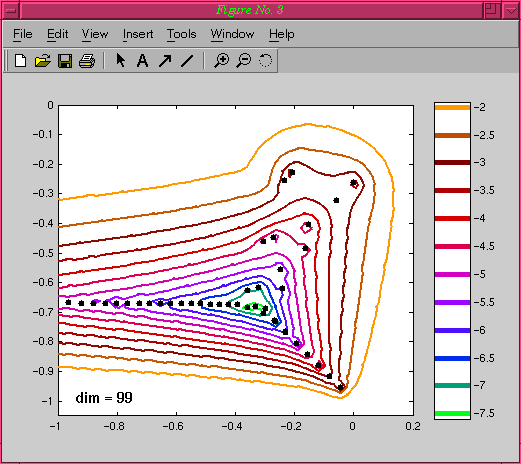
Note that if you want to be left with an EigTool session rather
than a printable plot, simply set opts.print_plot=0. For full
details of the options available, please see Command
Line Options.
Save for Quick Print Creation
For some problems, the time taken to compute the pseudospectra data
may be substantial, and so it is desirable to have a method of saving
the computed data needed to create the plot, rather than the options
used as above. If we use this menu option to save the data into a file
called, say, os_test.mat, the printable plot below (which is
identical to that above) can be instantly created using the command:
eigtool('os_test');

Arbitrary Levels
The exponentially spaced epsilon levels used as default by EigTool
are generally good, but for some problems more user control may be
desired. The Aribtrary Levels option is there to provide this by
allowing the user to enter their own levels via a text box:
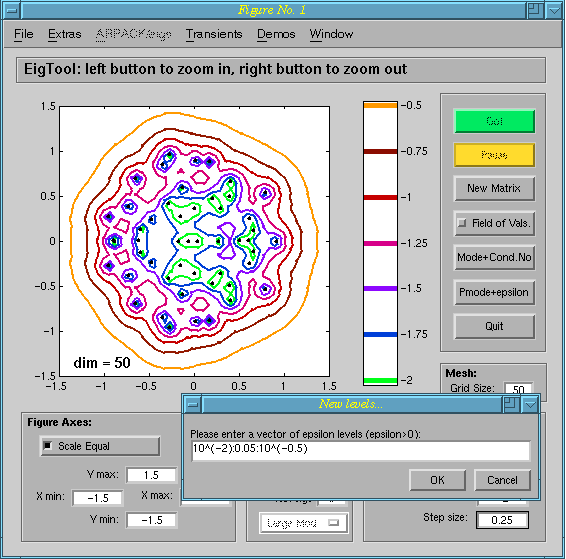
In this example, the Random Demo is
shown, but for this near-normal matrix equally spaced levels may be
more appropriate:
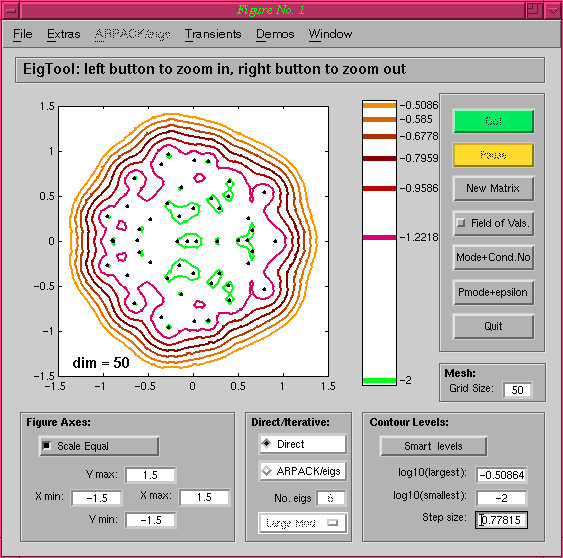
Notice that the levels shown in the colourbar are no longer equally
spaced as an indication that non-exponentially spaced levels are being used.
EigTool home page.






